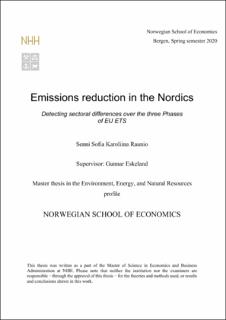| dc.description.abstract | This thesis investigates the correlation of the emissions and tradable allowances within
specific sectors of the European Union’s Emission Trading Scheme, in four Nordic countries:
Denmark, Finland, Norway and Sweden. The EU ETS is the corner stone of the EU’s climate
policies; it is a carbon market based on cap-and-trade mechanism. The idea is, that a carbon
tonne has a price and one carbon tonne is equivalent of one emitting permit called an
allowance. The EU ETS covers approximately 45% of the GHG emissions in EU with over
11,000 energy intensive installations. It has been in use for three Phases now, since 2005. The
Phase IV begins in 2021 and ends in 2030. The system has been criticised multiple times over
the years, and it has gone through reforms and expansions to new sectors in order to enhance
the system.
In this thesis, the relationship of the variables emissions and allowances is looked in the carbon
market in the European Union, by comparing the sectors of all stationary installations,
combustion of fuels and refining of mineral oil in the countries over the 14 years, 2005-2019.
Besides the carbon market, the Nordic climate ambitions and policies is researched. Based on
this research, the carbon trading does work in theory cost-effectively but as in reality this is
not always the case. The system is complex and the differences between the sectors and
countries affect the emissions trends, which might disturb the logic behind the scheme. In
theory the carbon market is meant to work so that decreasing the cap leads to decrease in
emissions. However, in the researched sectors in the four countries, this was not systematically
the case.
EU ETS is an interesting and important flagship policy for Europe, and it has been successful
in setting a price for carbon after the system has been modified over the 14 years it has been
in use. Many possibilities lie within the trading scheme and the future of it as part of the
European Union’s new Green Deal is crucial in order to achieve the climate goals of the
Member States, and the region. EU ETS can be seen as something unique globally, since it is
the largest carbon market in the world. If EU ETS is successful, it is possible that other regions
can achieve emissions reductions with similar system.
Keywords: EU ETS, GHG emissions, allowances, carbon market, polluter pays principle,
Nordics, climate policies, climate change | en_US |
